Related Research Articles
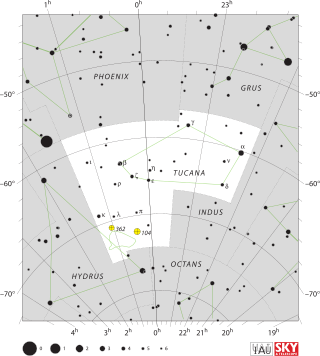
Tucana is a constellation of stars in the southern sky, named after the toucan, a South American bird. It is one of twelve constellations conceived in the late sixteenth century by Petrus Plancius from the observations of Pieter Dirkszoon Keyser and Frederick de Houtman. Tucana first appeared on a 35-centimetre-diameter (14 in) celestial globe published in 1598 in Amsterdam by Plancius and Jodocus Hondius and was depicted in Johann Bayer's star atlas Uranometria of 1603. French explorer and astronomer Nicolas Louis de Lacaille gave its stars Bayer designations in 1756. The constellations Tucana, Grus, Phoenix and Pavo are collectively known as the "Southern Birds".

Messier 100 is a grand design intermediate spiral galaxy in the southern part of the mildly northern Coma Berenices. It is one of the brightest and largest galaxies in the Virgo Cluster and is approximately 55 million light-years from our galaxy, its diameter being 107,000 light years, and being about 60% as large. It was discovered by Pierre Méchain in 1781 and 29 days later seen again and entered by Charles Messier in his catalogue "of nebulae and star clusters".. It was one of the first spiral galaxies to be discovered, and was listed as one of fourteen spiral nebulae by Lord William Parsons of Rosse in 1850. NGC 4323 and NGC 4328 are satellite galaxies of M100; the former is connected with it by a bridge of luminous matter.

Perseus is a constellation in the northern sky, named after the Greek mythological hero Perseus. It is one of the 48 ancient constellations listed by the 2nd-century astronomer Ptolemy, and among the 88 modern constellations defined by the International Astronomical Union (IAU). It is located near several other constellations named after ancient Greek legends surrounding Perseus, including Andromeda to the west and Cassiopeia to the north. Perseus is also bordered by Aries and Taurus to the south, Auriga to the east, Camelopardalis to the north, and Triangulum to the west. Some star atlases during the early 19th century also depicted Perseus holding the disembodied head of Medusa, whose asterism was named together as Perseus et Caput Medusae; however, this never came into popular usage.
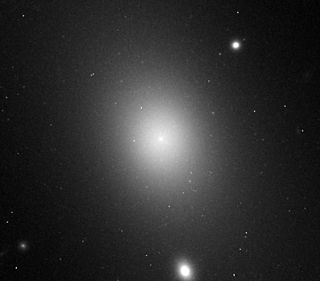
IC 1101 is a class S0 supergiant (cD) lenticular galaxy at the center of the Abell 2029 galaxy cluster. It has an isophotal diameter at about 123.65 to 169.61 kiloparsecs. It possesses a diffuse core which is the largest known core of any galaxy to date, and also hosts a supermassive black hole that is one of the largest black holes known. The galaxy is located at 354.0 megaparsecs from Earth. The galaxy was discovered on 19 June 1790, by the British astronomer William Herschel.

Palomar 12 is a globular cluster in the constellation Capricornus, and is a member of the Palomar Globular Clusters group.
A Hickson Compact Group is a collection of galaxies designated as published by Paul Hickson in 1982.
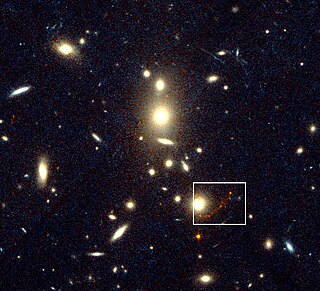
CL 1358+62 is a galaxy cluster located at z=0.33 redshift. Behind the cluster, lensed into a red arc is an infant galaxy that was the farthest object in the observable universe for a few months. It had a record redshift of z=4.92 and was discovered on July 31, 1997 by M. Franx and G. Illingsworth. It is located approximately 26 billion light years from Earth. Its redshift was measured by the Keck Telescope shortly after its discovery. Along with G1, another galaxy also lensed, was found to be at z=4.92. The pair of galaxies were the first things other than quasars to have the title of most distant object found, since the 1960s. The pair of galaxies remained the most distant objects known until the discovery of RD1 at z=5.34, the first object to exceed redshift 5.

Abell 39 is a low surface brightness planetary nebula in the constellation of Hercules. It is the 39th entry in George Abell's 1966 Abell Catalog of Planetary Nebulae of 86 old planetary nebulae which either Abell or Albert George Wilson discovered before August 1955 as part of the National Geographic Society - Palomar Observatory Sky Survey. It is estimated to be about 3,800 light-years from earth and thus 2,600 light-years above the Galactic plane. It is almost perfectly spherical and also one of the largest known spheres with a radius of about 1.4 light-years.
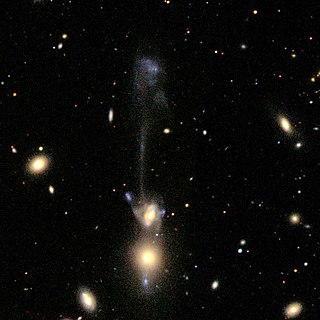
NGC 3561, also known as Arp 105, is a pair of interacting galaxies NGC 3561A and NGC 3561B within the galaxy cluster Abell 1185 in Ursa Major. Its common name is "the Guitar" and contains a small tidal dwarf galaxy known as Ambartsumian's Knot that is believed to be the remnant of the extensive tidal tail pulled out of one of the galaxies.
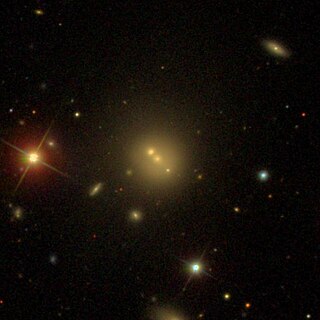
NGC 3550 is a lenticular galaxy in the constellation Ursa Major. It was discovered on April 11, 1785, by William Herschel. It is one of the brightest galaxies of the Abell 1185 galaxy cluster.

NGC 3539 is a lenticular galaxy in the constellation Ursa Major. It was discovered in April 1831 by John Herschel. It is a member of the galaxy cluster Abell 1185.
Abell 222 is a galaxy cluster in the constellation of Cetus. It holds thousands of galaxies together. It is located at a distance of 2.4 billion light-years from Earth.
Abell 223 is a galaxy cluster. It is located at a distance of 2.4 billion light-years from Earth. The cluster is connected to nearby cluster Abell 222 by a filament of matter. Research has shown that only 20% of that matter is normal. The rest is thought to be dark matter. This means that this would form the Abell 222/ Abell 223 Supercluster as we understand them.
Abell 7 is a faint planetary nebula located 1800 light-years away in the constellation of Lepus. It has a generally spherical shape about 8 light-years in diameter. Within the sphere are complex details that are brought out by narrowband filters. Abell 7 is estimated to be only 20,000 years old, but the central star, a fading white dwarf, is estimated to be some 10 billion years old.
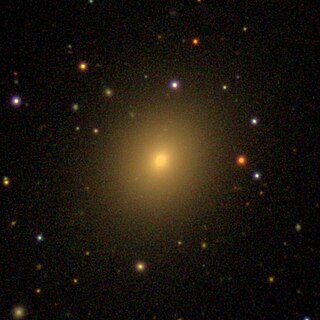
NGC 777 is an elliptical galaxy in the constellation of Triangulum. It was discovered by William Herschel on September 12, 1784. It has a weak active nucleus of type Seyfert 2 or LINER 2, implying that the central region is obscured. It may be an outlying member of galaxy cluster Abell 262.

Abell 3411 is a galaxy cluster in the constellation Hydra. It is located about two billion light-years from Earth and weighs about a million billion times the mass of the Sun.

Abell 3412 is a galaxy cluster in the constellation Hydra. It is located about two billion light-years from Earth and weighs about a million billion times the mass of the Sun.

NGC 5559 is a barred spiral galaxy, located 240 million light-years away in the constellation of Boötes. It was discovered on April 10, 1785, by the astronomer William Herschel.

NGC 4598 is a barred lenticular galaxy located in the constellation Virgo. NGC 4598 was discovered by astronomer William Herschel on April 15, 1784. The distance to NGC 4598 has not been accurately determined; measurements vary from 64 to 102 million light-years. According to the NASA/IPAC Extragalactic Database, its redshift based distance is 102 Mly (31.3 Mpc) while its redshift independent based distance is 88.71 Mly (27.200 Mpc). Also, according to SIMBAD, its distance is 63.7 Mly (19.54 Mpc). NGC 4598's average distance is 84.8 Mly (26.0 Mpc). NGC 4598 is usually considered to be a member of the Virgo Cluster. However, P. Fouqu´e et al. suggests it may be a background galaxy independent of the main cluster.
References
- 1 2 3 4 5 6 Mahdavi, Andisheh; Geller, Margaret J. (2001). "The LX− σ Relation for Galaxies and Clusters of Galaxies". The Astrophysical Journal. 554 (2): L129–L132. arXiv: astro-ph/0105315 . Bibcode:2001ApJ...554L.129M. doi:10.1086/321710. S2CID 118106523.
- 1 2 "2MASS J11011452-2243527". SIMBAD . Centre de données astronomiques de Strasbourg . Retrieved 3 April 2019.
- 1 2 Abell, George O.; Corwin, Harold G. Jr.; Olowin, Ronald P. (1989). "A catalog of rich clusters of galaxies". The Astrophysical Journal Supplement Series. 70: 1. Bibcode:1989ApJS...70....1A. doi: 10.1086/191333 .
- 1 2 "NED results for object ABELL 1146". NASA/IPAC Extragalactic Database. National Aeronautics and Space Administration / Infrared Processing and Analysis Center . Retrieved 3 April 2019.
- ↑ "ACO 1146". SIMBAD . Centre de données astronomiques de Strasbourg . Retrieved 3 April 2019.